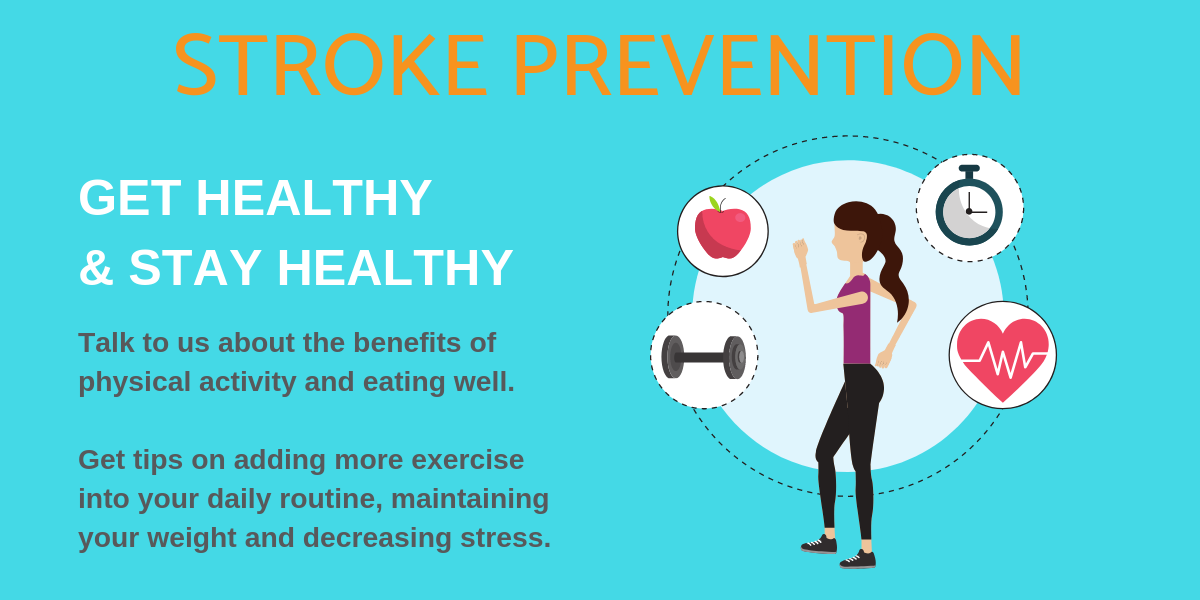Preventing Strokes
There are various steps taken in Strokes Prevention and Recognition. Strokes can be prevented in those at risk if steps are taken to prevent them. By using this method, an individual can improve his or her health and quality of life more effectively than by getting treatment after a stroke.
The following prevention methods may be discussed:
-
The primary prevention; or
-
The secondary prevention
The goal of primary prevention is to prevent someone from developing a disease in the first place. Here, we are referring to strokes or transient ischemic attacks.
A primary prevention strategy for strokes involves reducing stroke risk factors, which may include:
-
A smoking cessation program or medication to assist smokers in quitting
-
An individual’s blood pressure can be managed and controlled by managing and controlling it
-
Blood cholesterol levels can be lowered by taking statins or similar medications
-
Keeping someone’s diabetes under strict control
-
Exercise as a means of encouraging health
-
The reduction of alcohol consumption and improving the diet of obese patients in order to help them lose weight.
-
A reliable practice for treating atrial fibrillation or irregular heartbeats are prescribing blood thinners, such as Warfarin, which reduce the likelihood of blood clots. It is also critical to monitor how the medicine is affecting blood clotting using regular blood tests (INR tests).

A secondary prevention program is available for strokes and TIAs that can help detect them early and prevent them from becoming more serious. Sometimes it may be a bit complicated in the process of Strokes Prevention and Recognition. In many cases, strokes and TIAs are prevented through secondary prevention while someone is in the hospital for stroke treatment or TIA treatment. Many reasons may lead to the prescription of aspirin, including reducing the risk of blood clots. A carotid endarterectomy is a small surgical procedure to remove damaged carotid arteries. You may receive lifestyle advice, have your blood pressure lowered, have your cholesterol levels lowered, or have your cholesterol levels lowered. In this case, the carotid arteries of the patient are narrowing, increasing the possibility of a stroke in the future.
In the video below, which summarizes these points and discusses stroke and TIA prevention, you will learn more about these points.
This video is courtesy of Mechanisms in Medicine.
Recognition of Strokes
The video below provides a few recallable techniques for remembering stroke symptoms. And they include:
-
If the person’s face is drooping, ask them to smile. Does one side of the face droop?
-
If the person has a weakness in their arms, ask them to raise both arms. Does one arm drift downwards?
-
If the individual has difficulty speaking, he or she can repeat a simple phrase. Do you have any slurred or strange sounds in your speech?
-
You need a medical emergency service if any of these signs are present. Dial 999 immediately.
It may already be familiar to you that the U.S Department of Health and Human Services launched the Centers for disease control and prevention (CDC) in order to raise awareness of health related issues as well as the stroke symptoms. Below is a short video that you may find informative.
The video is courtesy of Centers for disease control and prevention (CDC).
The most important thing to do in the event of a stroke is to seek medical attention immediately because the Strokes Prevention and Recognition needs immediate intervention. A stroke can occur at any time in life due to the effects of time on the brain. A person who delays seeking medical treatment is more likely to have his or her brain damaged for a long period of time. It is extremely significant that you immediately seek medical attention if you are unsure whether someone is suffering from a stroke. For healthcare professionals to determine which treatment is most effective, they must note the time when symptoms first appeared.
In most cases, people who suffer from TIAs feel better within a few minutes of experiencing symptoms. TIAs are severe and, if left untreated, they can develop into strokes. Even though TIAs rarely last long, they are often indicative of underlying health issues. It is imperative to seek medical attention immediately regardless of whether symptoms of TIA have subsided.
Aside from facial drooping and arm weakness on a particular side of the body, strokes and TIAs can also cause several other symptoms.

Among them are:
-
The face, arms, or legs on one side of the body are numb
-
Suddenly having difficulty understanding what someone is saying
-
One or both eyes are unable to see suddenly
-
Having difficulty walking, feeling dizzy, or losing balance suddenly
-
Suddenly having difficulty coordinating
-
Without a known cause, a severe headache appears out of nowhere
-
Tiredness that occurs suddenly
-
The feeling of nausea and vomiting